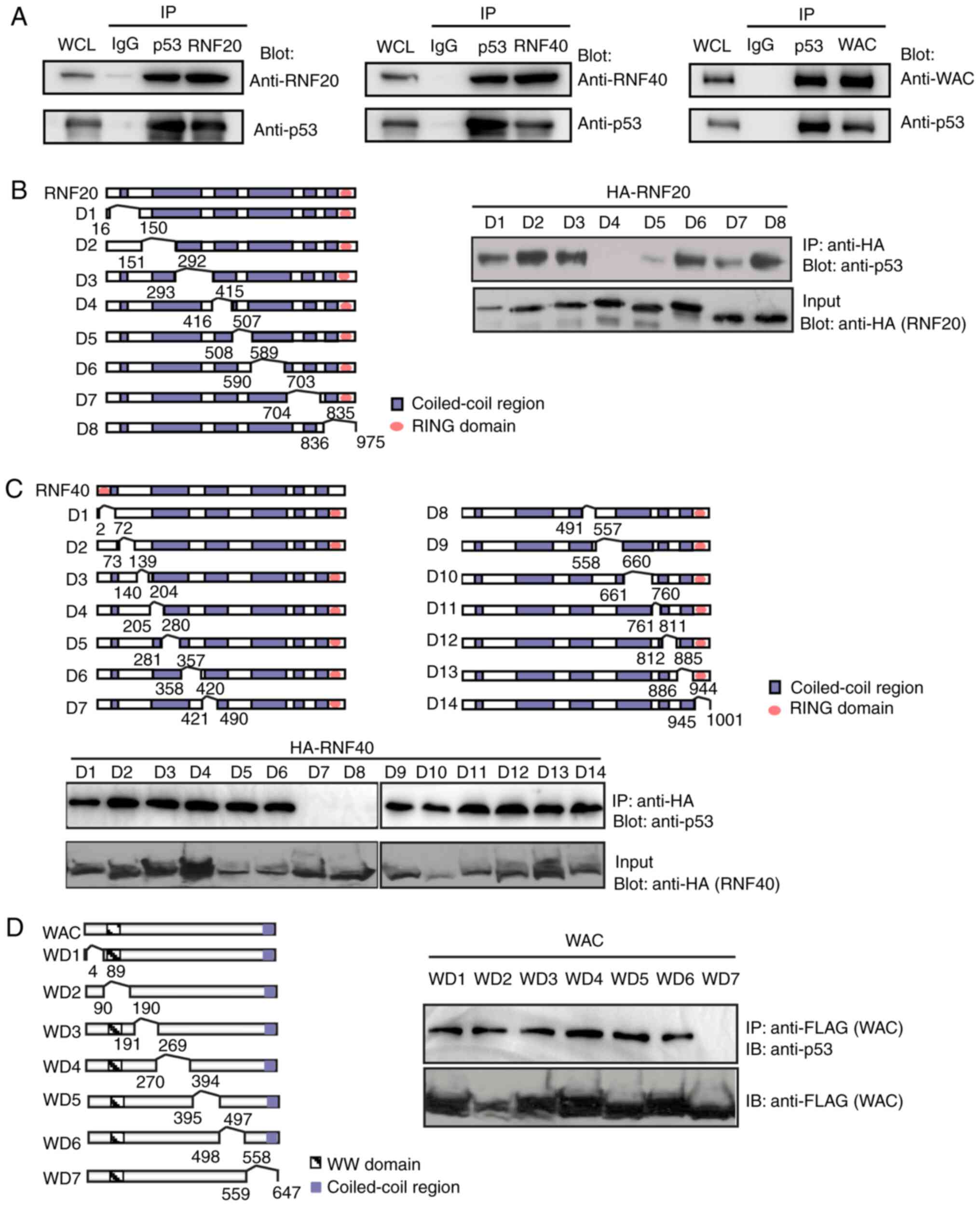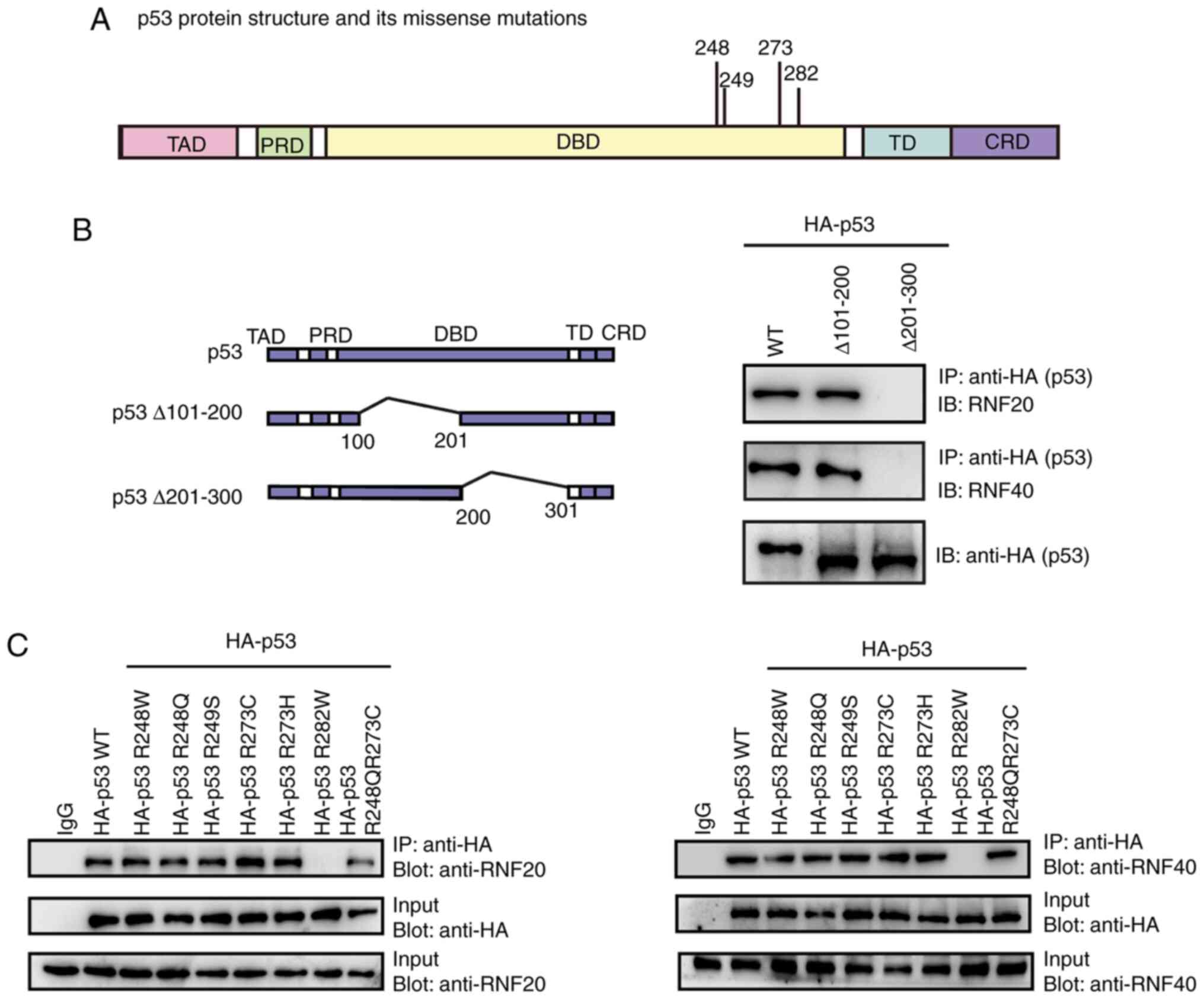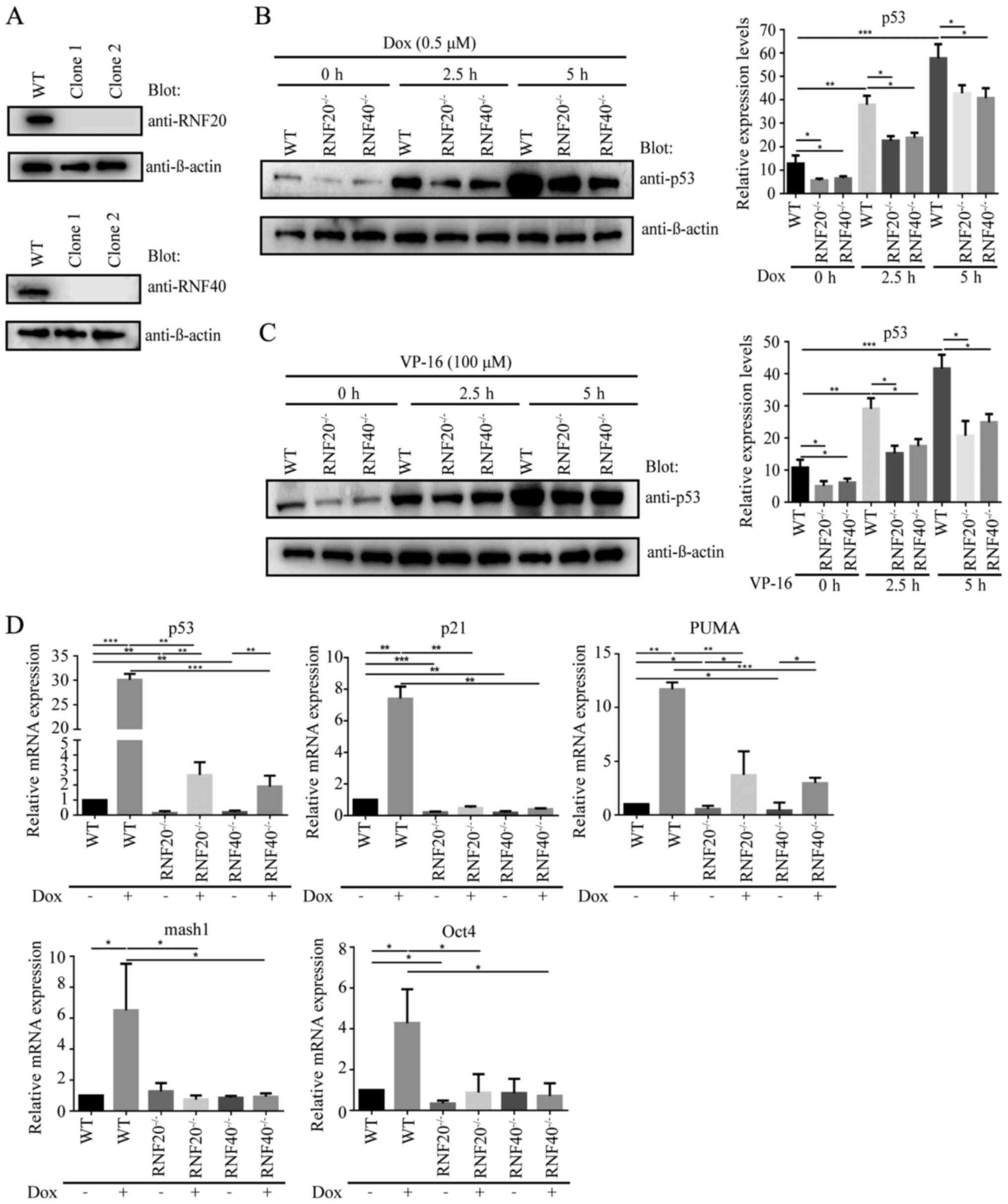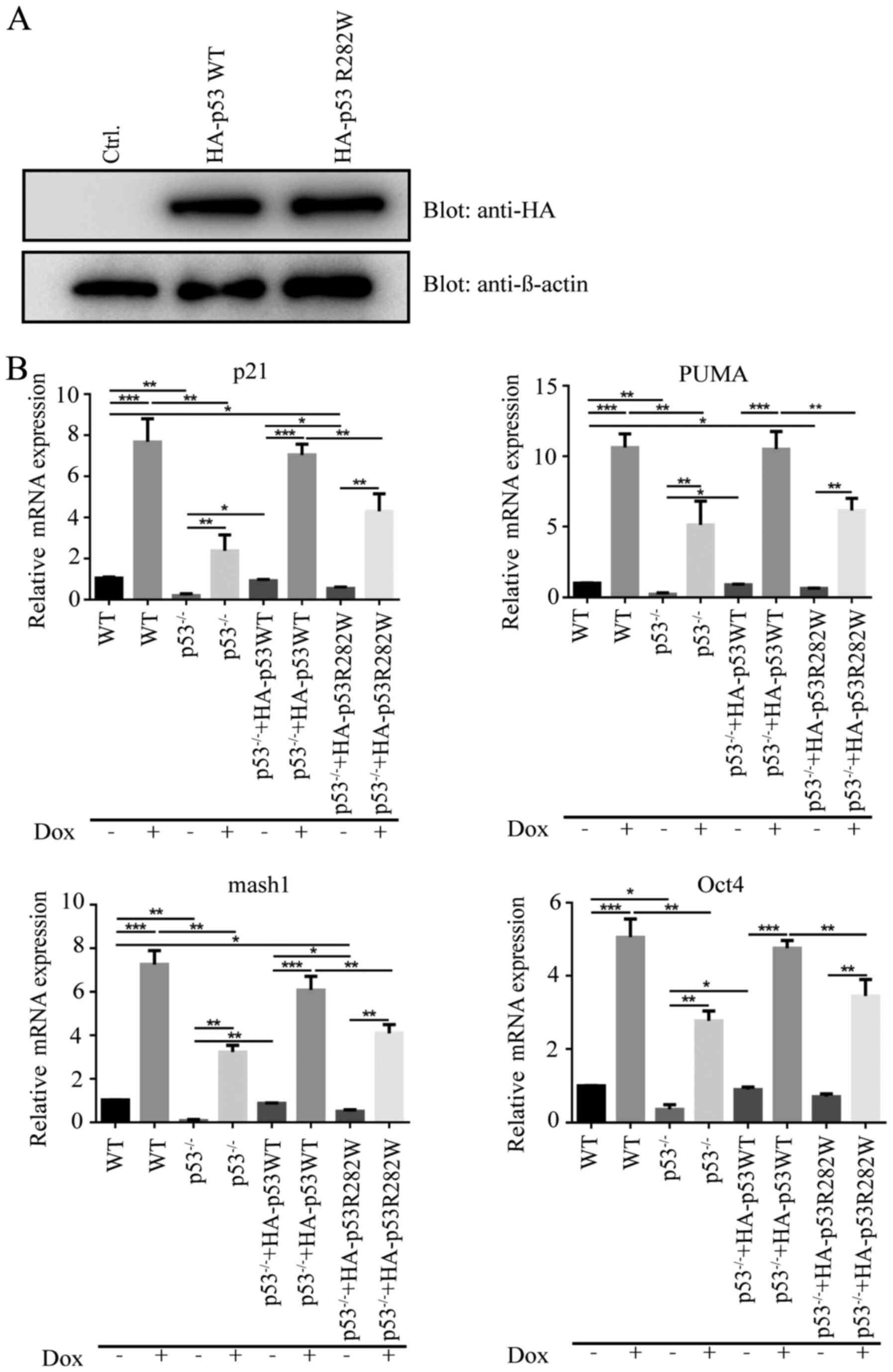|
1
|
Bieging KT, Mello SS and Attardi LD:
Unravelling mechanisms of p53-mediated tumour suppression. Nat Rev
Cancer. 14:359–370. 2014. View
Article : Google Scholar : PubMed/NCBI
|
|
2
|
Joerger AC and Fersht AR: Structural
biology of the tumor suppressor p53. Annu Rev Biochem. 77:557–582.
2008. View Article : Google Scholar : PubMed/NCBI
|
|
3
|
Joerger AC and Fersht AR: Structural
biology of the tumor suppressor p53 and cancer-associated mutants.
Adv Cancer Res. 97:1–23. 2007. View Article : Google Scholar : PubMed/NCBI
|
|
4
|
Ozaki T and Nakagawara A: Role of p53 in
Cell Death and Human Cancers. Cancers (Basel). 3:994–1013. 2011.
View Article : Google Scholar : PubMed/NCBI
|
|
5
|
Joerger AC and Fersht AR:
Structure-function-rescue: The diverse nature of common p53 cancer
mutants. Oncogene. 26:2226–2242. 2007. View Article : Google Scholar : PubMed/NCBI
|
|
6
|
Riley T, Sontag E, Chen P and Levine A:
Transcriptional control of human p53-regulated genes. Nat Rev Mol
Cell Biol. 9:402–412. 2008. View
Article : Google Scholar : PubMed/NCBI
|
|
7
|
Allen MA, Andrysik Z, Dengler VL, Mellert
HS, Guarnieri A, Freeman JA, Sullivan KD, Galbraith MD, Luo X,
Kraus WL, et al: Global analysis of p53-regulated transcription
identifies its direct targets and unexpected regulatory mechanisms.
eLife. 3:e022002014. View Article : Google Scholar : PubMed/NCBI
|
|
8
|
Dai C and Gu W: p53 post-translational
modification: Deregulated in tumorigenesis. Trends Mol Med.
16:528–536. 2010. View Article : Google Scholar : PubMed/NCBI
|
|
9
|
Bernard M, Yang B, Migneault F, Turgeon J,
Dieudé M, Olivier MA, Cardin GB, El-Diwany M, Underwood K, Rodier
F, et al: Autophagy drives fibroblast senescence through MTORC2
regulation. Autophagy. 16:2004–2016. 2020. View Article : Google Scholar : PubMed/NCBI
|
|
10
|
Ho CJ, Lin RW, Zhu WH, Wen TK, Hu CJ, Lee
YL, Hung TI and Wang C: Transcription-independent and -dependent
p53-mediated apoptosis in response to genotoxic and non-genotoxic
stress. Cell Death Discov. 5:1312019. View Article : Google Scholar : PubMed/NCBI
|
|
11
|
Follis AV, Llambi F, Ou L, Baran K, Green
DR and Kriwacki RW: The DNA-binding domain mediates both nuclear
and cytosolic functions of p53. Nat Struct Mol Biol. 21:535–543.
2014. View Article : Google Scholar : PubMed/NCBI
|
|
12
|
Mrakovcic M and Frohlich LF: p53-mediated
molecular control of autophagy in tumor cells. Biomolecules.
8:142018. View Article : Google Scholar
|
|
13
|
Clapier CR and Cairns BR: The biology of
chromatin remodeling complexes. Annu Rev Biochem. 78:273–304. 2009.
View Article : Google Scholar : PubMed/NCBI
|
|
14
|
Cole AJ, Clifton-Bligh R and Marsh DJ:
Histone H2B monoubiquitination: Roles to play in human malignancy.
Endocr Relat Cancer. 22:T19–T33. 2015. View Article : Google Scholar : PubMed/NCBI
|
|
15
|
Chandrasekharan MB, Huang F and Sun ZW:
Histone H2B ubiquitination and beyond: Regulation of nucleosome
stability, chromatin dynamics and the trans-histone H3 methylation.
Epigenetics. 5:460–468. 2010. View Article : Google Scholar : PubMed/NCBI
|
|
16
|
Hammond-Martel I, Yu H and Affar B: Roles
of ubiquitin signaling in transcription regulation. Cell Signal.
24:410–421. 2012. View Article : Google Scholar : PubMed/NCBI
|
|
17
|
Buetow L and Huang DT: Structural insights
into the catalysis and regulation of E3 ubiquitin ligases. Nat Rev
Mol Cell Biol. 17:626–642. 2016. View Article : Google Scholar : PubMed/NCBI
|
|
18
|
Shiloh Y, Shema E, Moyal L and Oren M:
RNF20-RNF40: A ubiquitin-driven link between gene expression and
the DNA damage response. FEBS Lett. 585:2795–2802. 2011. View Article : Google Scholar : PubMed/NCBI
|
|
19
|
Zhang K, Wang J, Tong TR, Wu X, Nelson R,
Yuan YC, Reno T, Liu Z, Yun X, Kim JY, et al: Loss of H2B
monoubiquitination is associated with poor-differentiation and
enhanced malignancy of lung adenocarcinoma. Int J Cancer.
141:766–777. 2017. View Article : Google Scholar : PubMed/NCBI
|
|
20
|
Shema E, Tirosh I, Aylon Y, Huang J, Ye C,
Moskovits N, Raver-Shapira N, Minsky N, Pirngruber J, Tarcic G, et
al: The histone H2B-specific ubiquitin ligase RNF20/hBRE1 acts as a
putative tumor suppressor through selective regulation of gene
expression. Genes Dev. 22:2664–2676. 2008. View Article : Google Scholar : PubMed/NCBI
|
|
21
|
Zhang F and Yu X: WAC, a functional
partner of RNF20/40, regulates histone H2B ubiquitination and gene
transcription. Mol Cell. 41:384–397. 2011. View Article : Google Scholar : PubMed/NCBI
|
|
22
|
Johnsen SA: The enigmatic role of H2Bub1
in cancer. FEBS Lett. 586:1592–1601. 2012. View Article : Google Scholar : PubMed/NCBI
|
|
23
|
Sethi G, Shanmugam MK, Arfuso F and Kumar
AP: Role of RNF20 in cancer development and progression - a
comprehensive review. Biosci Rep. 38:BSR201712872018. View Article : Google Scholar : PubMed/NCBI
|
|
24
|
Chernikova SB, Razorenova OV, Higgins JP,
Sishc BJ, Nicolau M, Dorth JA, Chernikova DA, Kwok S, Brooks JD,
Bailey SM, et al: Deficiency in mammalian histone H2B ubiquitin
ligase Bre1 (Rnf20/Rnf40) leads to replication stress and
chromosomal instability. Cancer Res. 72:2111–2119. 2012. View Article : Google Scholar : PubMed/NCBI
|
|
25
|
Lee JH, Jeon YG, Lee KH, Lee HW, Park J,
Jang H, Kang M, Lee HS, Cho HJ, Nam DH, et al: RNF20 Suppresses
Tumorigenesis by Inhibiting the SREBP1c-PTTG1 Axis in Kidney
Cancer. Mol Cell Biol. 37:e00265–17. 2017. View Article : Google Scholar : PubMed/NCBI
|
|
26
|
Tarcic O, Granit RZ, Pateras IS, Masury H,
Maly B, Zwang Y, Yarden Y, Gorgoulis VG, Pikarsky E, Ben-Porath I,
et al: RNF20 and histone H2B ubiquitylation exert opposing effects
in Basal-Like versus luminal breast cancer. Cell Death Differ.
24:694–704. 2017. View Article : Google Scholar : PubMed/NCBI
|
|
27
|
Wu C, Cui Y, Liu X, Zhang F, Lu LY and Yu
X: The RNF20/40 complex regulates p53-dependent gene transcription
and mRNA splicing. J Mol Cell Biol. 12:113–124. 2020. View Article : Google Scholar : PubMed/NCBI
|
|
28
|
Tzin V, Rogachev I, Meir S, Moyal Ben Zvi
M, Masci T, Vainstein A, Aharoni A and Galili G: Tomato fruits
expressing a bacterial feedback-insensitive
3-deoxy-D-arabino-heptulosonate 7-phosphate synthase of the
shikimate pathway possess enhanced levels of multiple specialized
metabolites and upgraded aroma. J Exp Bot. 64:4441–4452. 2013.
View Article : Google Scholar : PubMed/NCBI
|
|
29
|
Kitzman JO, Starita LM, Lo RS, Fields S
and Shendure J: Massively parallel single-amino-acid mutagenesis.
Nat Methods. 12:203–206, 4 p following 206. 2015. View Article : Google Scholar : PubMed/NCBI
|
|
30
|
Livak KJ and Schmittgen TD: Analysis of
relative gene expression data using real-time quantitative PCR and
the 2(-Delta Delta C(T)) method. Methods. 25:402–408. 2001.
View Article : Google Scholar : PubMed/NCBI
|
|
31
|
Stiewe T and Haran TE: How mutations shape
p53 interactions with the genome to promote tumorigenesis and drug
resistance. Drug Resist Updat. 38:27–43. 2018. View Article : Google Scholar : PubMed/NCBI
|
|
32
|
Shema E, Tirosh I, Aylon Y, Huang J, Ye C,
Moskovits N, Raver-Shapira N, Minsky N, Pirngruber J, Tarcic G, et
al: Corrigendum: The histone H2B-specific ubiquitin ligase
RNF20/hBRE1 acts as a putative tumor suppressor through selective
regulation of gene expression. Genes Dev. 31:19262017. View Article : Google Scholar : PubMed/NCBI
|
|
33
|
Hwang WW, Venkatasubrahmanyam S,
Ianculescu AG, Tong A, Boone C and Madhani HD: A conserved RING
finger protein required for histone H2B monoubiquitination and cell
size control. Mol Cell. 11:261–266. 2003. View Article : Google Scholar : PubMed/NCBI
|
|
34
|
Nakamura K, Kato A, Kobayashi J,
Yanagihara H, Sakamoto S, Oliveira DV, Shimada M, Tauchi H, Suzuki
H, Tashiro S, et al: Regulation of homologous recombination by
RNF20-dependent H2B ubiquitination. Mol Cell. 41:515–528. 2011.
View Article : Google Scholar : PubMed/NCBI
|
|
35
|
Kao CF, Hillyer C, Tsukuda T, Henry K,
Berger S and Osley MA: Rad6 plays a role in transcriptional
activation through ubiquitylation of histone H2B. Genes Dev.
18:184–195. 2004. View Article : Google Scholar : PubMed/NCBI
|
|
36
|
Tang Q, Su Z, Gu W and Rustgi AK: Mutant
p53 on the path to metastasis. Trends Cancer. 6:62–73. 2020.
View Article : Google Scholar : PubMed/NCBI
|
|
37
|
Vousden KH and Prives C: Blinded by the
Light: The growing complexity of p53. Cell. 137:413–431. 2009.
View Article : Google Scholar : PubMed/NCBI
|
|
38
|
Li H, Zhang J, Tong JHM, Chan AWH, Yu J,
Kang W and To KF: Targeting the oncogenic p53 mutants in colorectal
cancer and other solid tumors. Int J Mol Sci. 20:59992019.
View Article : Google Scholar
|
|
39
|
Hanel W, Marchenko N, Xu S, Yu SX, Weng W
and Moll U: Two hot spot mutant p53 mouse models display
differential gain of function in tumorigenesis. Cell Death Differ.
20:898–909. 2013. View Article : Google Scholar : PubMed/NCBI
|
|
40
|
Cho Y, Gorina S, Jeffrey PD and Pavletich
NP: Crystal structure of a p53 tumor suppressor-DNA complex:
Understanding tumorigenic mutations. Science. 265:346–355. 1994.
View Article : Google Scholar : PubMed/NCBI
|
|
41
|
Petitjean A, Mathe E, Kato S, Ishioka C,
Tavtigian SV, Hainaut P and Olivier M: Impact of mutant p53
functional properties on TP53 mutation patterns and tumor
phenotype: Lessons from recent developments in the IARC TP53
database. Hum Mutat. 28:622–629. 2007. View Article : Google Scholar : PubMed/NCBI
|
|
42
|
Kumar P and Wolberger C: Structure of the
yeast Bre1 RING domain. Proteins. 83:1185–1190. 2015. View Article : Google Scholar : PubMed/NCBI
|
|
43
|
Shanmugam MK, Arfuso F, Arumugam S,
Chinnathambi A, Jinsong B, Warrier S, Wang LZ, Kumar AP, Ahn KS,
Sethi G, et al: Role of novel histone modifications in cancer.
Oncotarget. 9:11414–11426. 2017. View Article : Google Scholar : PubMed/NCBI
|
|
44
|
Menendez D, Nguyen TA, Freudenberg JM,
Mathew VJ, Anderson CW, Jothi R and Resnick MA: Diverse stresses
dramatically alter genome-wide p53 binding and transactivation
landscape in human cancer cells. Nucleic Acids Res. 41:7286–7301.
2013. View Article : Google Scholar : PubMed/NCBI
|
|
45
|
Stein Y, Rotter V and Aloni-Grinstein R:
Gain-of-function mutant p53: All the roads lead to tumorigenesis.
Int J Mol Sci. 20:61972019. View Article : Google Scholar
|
|
46
|
Zhang Y, Coillie SV, Fang JY and Xu J:
Gain of function of mutant p53: R282W on the peak? Oncogenesis.
5:e1962016. View Article : Google Scholar : PubMed/NCBI
|
|
47
|
Xu J, Wang J, Hu Y, Qian J, Xu B, Chen H,
Zou W and Fang JY: Unequal prognostic potentials of p53
gain-of-function mutations in human cancers associate with
drug-metabolizing activity. Cell Death Dis. 5:e11082014. View Article : Google Scholar : PubMed/NCBI
|
|
48
|
Calhoun S and Daggett V: Structural
effects of the L145Q, V157F, and R282W cancer-associated mutations
in the p53 DNA-binding core domain. Biochemistry. 50:5345–5353.
2011. View Article : Google Scholar : PubMed/NCBI
|
|
49
|
Deyoung MP and Ellisen LW: p63 and p73 in
human cancer: Defining the network. Oncogene. 26:5169–5183. 2007.
View Article : Google Scholar : PubMed/NCBI
|
|
50
|
Ali A, Shah AS and Ahmad A:
Gain-of-function of mutant p53: Mutant p53 enhances cancer
progression by inhibiting KLF17 expression in invasive breast
carcinoma cells. Cancer Lett. 354:87–96. 2014. View Article : Google Scholar : PubMed/NCBI
|
|
51
|
Neilsen PM, Noll JE, Mattiske S, Bracken
CP, Gregory PA, Schulz RB, Lim SP, Kumar R, Suetani RJ, Goodall GJ,
et al: Mutant p53 drives invasion in breast tumors through
up-regulation of miR-155. Oncogene. 32:2992–3000. 2013. View Article : Google Scholar : PubMed/NCBI
|
|
52
|
Xu J, Qian J, Hu Y, Wang J, Zhou X, Chen H
and Fang JY: Heterogeneity of Li-Fraumeni syndrome links to unequal
gain-of-function effects of p53 mutations. Sci Rep. 4:42232014.
View Article : Google Scholar : PubMed/NCBI
|
|
53
|
Zhang Y and Hunter T: Roles of Chk1 in
cell biology and cancer therapy. Int J Cancer. 134:1013–1023. 2014.
View Article : Google Scholar : PubMed/NCBI
|
|
54
|
Tarcic O, Pateras IS, Cooks T, Shema E,
Kanterman J, Ashkenazi H, Boocholez H, Hubert A, Rotkopf R,
Baniyash M, et al: RNF20 Links histone H2B ubiquitylation with
inflammation and inflammation-associated cancer. Cell Rep.
14:1462–1476. 2016. View Article : Google Scholar : PubMed/NCBI
|
|
55
|
Hooda J, Novak M, Salomon MP, Matsuba C,
Ramos RI, MacDuffie E, Song M, Hirsch MS, Lester J, Parkash V, et
al: Early loss of histone H2B monoubiquitylation alters chromatin
accessibility and activates key immune pathways that facilitate
progression of ovarian cancer. Cancer Res. 79:760–772. 2019.
View Article : Google Scholar : PubMed/NCBI
|
|
56
|
Zhang Y, Yao L, Zhang X, Ji H, Wang L, Sun
S and Pang D: Elevated expression of USP22 in correlation with poor
prognosis in patients with invasive breast cancer. J Cancer Res
Clin Oncol. 137:1245–1253. 2011. View Article : Google Scholar : PubMed/NCBI
|
|
57
|
Minsky N, Shema E, Field Y, Schuster M,
Segal E and Oren M: Monoubiquitinated H2B is associated with the
transcribed region of highly expressed genes in human cells. Nat
Cell Biol. 10:483–488. 2008. View Article : Google Scholar : PubMed/NCBI
|
|
58
|
Prenzel T, Begus-Nahrmann Y, Kramer F,
Hennion M, Hsu C, Gorsler T, Hintermair C, Eick D, Kremmer E,
Simons M, et al: Estrogen-dependent gene transcription in human
breast cancer cells relies upon proteasome-dependent
monoubiquitination of histone H2B. Cancer Res. 71:5739–5753. 2011.
View Article : Google Scholar : PubMed/NCBI
|
|
59
|
Mimnaugh EG, Chen HY, Davie JR, Celis JE
and Neckers L: Rapid deubiquitination of nucleosomal histones in
human tumor cells caused by proteasome inhibitors and stress
response inducers: Effects on replication, transcription,
translation, and the cellular stress response. Biochemistry.
36:14418–14429. 1997. View Article : Google Scholar : PubMed/NCBI
|
|
60
|
Skinner HD, Sandulache VC, Ow TJ, Meyn RE,
Yordy JS, Beadle BM, Fitzgerald AL, Giri U, Ang KK and Myers JN:
TP53 disruptive mutations lead to head and neck cancer treatment
failure through inhibition of radiation-induced senescence. Clin
Cancer Res. 18:290–300. 2012. View Article : Google Scholar : PubMed/NCBI
|
|
61
|
Okaichi K, Ide-Kanematsu M, Izumi N,
Morita N, Okumura Y and Ihara M: Variations in sensitivity to
ionizing radiation in relation to p53 mutation point. Anticancer
Res. 28((5A)): 2687–2690. 2008.PubMed/NCBI
|


















